Submitted:
08 March 2024
Posted:
08 March 2024
You are already at the latest version
Abstract
Keywords:
1. Introduction
2. Materials and Methods
3. Results
3.1. Structural Properties
3.2. Elastic and Mechanical Properties
3.3. Lattice Dynamics
3.4. Electronic Properties
4. Conclusions
Supplementary Materials
Author Contributions
Acknowledgments
Conflicts of Interest
References
- Gmelin, L. Gmelin Handbook Der Anorganischen Chemie; Springer, 1984. [Google Scholar]
- Muller, O.; Roy, R. The Major Ternary Structural Families. (No Title) 1974.
- Dollase, W.A.; Seifert, F.; O’Neill, H.S.C. Structure of Cr2SiO4 and Possible Metal-Metal Interactions in Crystal and Melt. Phys Chem Miner 1994, 21, 104–109. [Google Scholar] [CrossRef]
- Zachariasen, W.H.; Ziegler, G.E. The Crystal Structure of Anhydrous Sodium Sulfate Na2SO4. Zeitschrift für Kristallographie-Crystalline Materials 1932, 81, 92–101. [Google Scholar] [CrossRef]
- Mehrotra, B.N.; Th, H.; Eysel, W.; Röpke, H.; Illguth, A. CRYSTAL CHEMISTRY OF COMPOUNDS WITH THENARDITE (Na2SO4V) STRUCTURE. 1978. [Google Scholar]
- Hesse, K.F.; Eysel, W. Structure of Dimercury (II) Germanate (IV). Acta Crystallogr B 1981, 37, 429–431. [Google Scholar] [CrossRef]
- Glasser, L.S.D.; Glasser, F.P. The Preparation and Crystal Data of the Cadmium Silicates CdSiO3, Cd2SiO4, and Cd3SiO5. Inorg Chem 1964, 3, 1228–1230. [Google Scholar] [CrossRef]
- Weil, M. Parawollastonite-Type Cd3[Si3O9]. Acta Crystallogr Sect E Struct Rep Online 2005, 61, i102–i104. [Google Scholar] [CrossRef]
- Lei, B.; Liu, Y.; Ye, Z.; Shi, C. Luminescence Properties of CdSiO3:Mn2+ Phosphor. J Lumin 2004, 109, 215–219. [Google Scholar] [CrossRef]
- den Eeckhout, K.; Smet, P.F.; Poelman, D. Persistent Luminescence in Eu2+-Doped Compounds: A Review. Materials 2010, 3, 2536–2566. [Google Scholar] [CrossRef]
- Aitasalo, T.; Hölsä, J.; Jungner, H.; Lastusaari, M.; Niittykoski, J. Thermoluminescence Study of Persistent Luminescence Materials: Eu2+-and R3+-Doped Calcium Aluminates, CaAl2O4:Eu2+, R3+. J Phys Chem B 2006, 110, 4589–4598. [Google Scholar] [CrossRef]
- Liu, Y.; Lei, B.; Shi, C. Luminescent Properties of a White Afterglow Phosphor CdSiO3:Dy3+. Chemistry of materials 2005, 17, 2108–2113. [Google Scholar] [CrossRef]
- Eysel, W. Kristallchemie von Oxyorthoverbindungen A3 0 [B04]. Neues Jahrb. Mineral. Monatsh 1970, 1970, 534–547. [Google Scholar]
- Wedepohl, K.H.; Correns, C.W.; Shaw, D.M.; Turekian, K.K.; Zemann, J. Handbook of Geochemistry; Springer, 1969; Vol. 2. [Google Scholar]
- Miletich, R.; Seifert, F.; Angel, R.J. Compression of Cadmium Orthosilicate, Cd2SiO4: A High-Pressure Single-Crystal Diffraction Study. Zeitschrift für Kristallographie-Crystalline Materials 1998, 213, 288–295. [Google Scholar] [CrossRef]
- Miletich, R.; Nowak, M.; Seifert, F.; Angel, R.J.; Brandstätter, G. High-Pressure Crystal Chemistry of Chromous Orthosilicate, Cr2SiO4. A Single-Crystal X-Ray Diffraction and Electronic Absorption Spectroscopy Study. Phys Chem Miner 1999, 26, 446–459. [Google Scholar] [CrossRef]
- Kresse, G.; Furthmüller, J. Efficiency of Ab-Initio Total Energy Calculations for Metals and Semiconductors Using a Plane-Wave Basis Set. Comput Mater Sci 1996, 6, 15–50. [Google Scholar] [CrossRef]
- Perdew, J.P.; Ruzsinszky, A.; Csonka, G.I.; Vydrov, O.A.; Scuseria, G.E.; Constantin, L.A.; Zhou, X.; Burke, K. Restoring the Density-Gradient Expansion for Exchange in Solids and Surfaces. Phys. Rev. Lett. 2008, 100, 136406. [Google Scholar] [CrossRef] [PubMed]
- Perdew, J.P.; Burke, K.; Ernzerhof, M. Generalized Gradient Approximation Made Simple. Phys. Rev. Lett. 1996, 77, 3865–3868. [Google Scholar] [CrossRef] [PubMed]
- Monkhorst, H.J.; Pack, J.D. Special Points for Brillouin-Zone Integrations. Phys Rev B 1976, 13, 5188–5192. [Google Scholar] [CrossRef]
- Gonze, X.; Lee, C. Dynamical Matrices, Born Effective Charges, Dielectric Permittivity Tensors, and Interatomic Force Constants from Density-Functional Perturbation Theory. Phys Rev B Condens Matter Mater Phys 1997, 55, 10355–10368. [Google Scholar] [CrossRef]
- Heyd, J.; Scuseria, G.E.; Ernzerhof, M. Hybrid Functionals Based on a Screened Coulomb Potential. J Chem Phys 2003, 118, 8207–8215. [Google Scholar] [CrossRef]
- Birch, F. Finite Elastic Strain of Cubic Crystals. Physical Review 1947, 71, 809–824. [Google Scholar] [CrossRef]
- Drickamer, H.G.; Lynch, R.W.; Clendenen, R.L.; Perez-Albueene, E.A. X-Ray Diffraction Studies of the Lattice Parameters of Solids under Very High Pressure. In Solid State Physics; Elsevier, 1967; Vol. 19, pp. 135–228. [Google Scholar]
- Ruiz-Fuertes, J.; Friedrich, A.; Errandonea, D.; Segura, A.; Morgenroth, W.; Rodríguez-Hernández, P.; Muñoz, A.; Meng, Y. Optical and Structural Study of the Pressure-Induced Phase Transition of CdWO4. Phys Rev B 2017, 95, 174105. [Google Scholar] [CrossRef]
- Isaak, D.G.; Graham, E.K.; Bass, J.D.; Wang, H. The Elastic Properties of Single-Crystal Fayalite as Determined by Dynamical Measurement Techniques. Pure Appl Geophys 1993, 141, 393–414. [Google Scholar] [CrossRef]
- Sharp, Z.D.; Hazen, R.M.; Finger, L.W. High-Pressure Crystal Chemistry of Monticellite, CaMgSiO4. American Mineralogist 1987, 72, 748–755. [Google Scholar]
- Nye, J.F. Physical Properties of Crystals: Their Representation by Tensors and Matrices; Oxford university press, 1985. [Google Scholar]
- Mouhat, F.; Coudert, F.-X. Necessary and Sufficient Elastic Stability Conditions in Various Crystal Systems. Phys Rev B 2014, 90, 224104. [Google Scholar] [CrossRef]
- Reuß, A. Berechnung Der Fließgrenze von Mischkristallen Auf Grund Der Plastizitätsbedingung Für Einkristalle. ZAMM-Journal of Applied Mathematics and Mechanics/Zeitschrift für Angewandte Mathematik und Mechanik 1929, 9, 49–58. [Google Scholar] [CrossRef]
- Hill, R. The Elastic Behaviour of a Crystalline Aggregate. Proceedings of the Physical Society. Section A 1952, 65, 349. [Google Scholar] [CrossRef]
- Pugh, S.F. XCII. Relations between the Elastic Moduli and the Plastic Properties of Polycrystalline Pure Metals. The London, Edinburgh, and Dublin Philosophical Magazine and Journal of Science 1954, 45, 823–843. [Google Scholar] [CrossRef]
- Lewandowski*, J.J.; Wang, W.H.; Greer, A.L. Intrinsic Plasticity or Brittleness of Metallic Glasses. Philos Mag Lett 2005, 85, 77–87. [Google Scholar] [CrossRef]
- Köster, W.; Franz, H. Poisson’s Ratio for Metals and Alloys. Metallurgical reviews 1961, 6, 1–56. [Google Scholar] [CrossRef]
- Ledbetter, M.H. Materials at Low Temperatures, Edited by RP Reed and AF Clark American Society for Metals. Metals Park, OH 1983, 1. [Google Scholar]
- Ravindran, P.; Fast, L.; Korzhavyi, P.A.; Johansson, B.; Wills, J.; Eriksson, O. Density Functional Theory for Calculation of Elastic Properties of Orthorhombic Crystals: Application to TiSi2. J Appl Phys 1998, 84, 4891–4904. [Google Scholar] [CrossRef]
- Chung, D.H.; Buessem, W.R. The Elastic Anisotropy of Crystals. J Appl Phys 1967, 38, 2010–2012. [Google Scholar] [CrossRef]
- Ranganathan, S.I.; Ostoja-Starzewski, M. Universal Elastic Anisotropy Index. Phys Rev Lett 2008, 101, 55504. [Google Scholar] [CrossRef] [PubMed]
- Brugger, K. Determination of Third-Order Elastic Coefficients in Crystals. J Appl Phys 1965, 36, 768–773. [Google Scholar] [CrossRef]
- Music, D.; Houben, A.; Dronskowski, R.; Schneider, J.M. Ab Initio Study of Ductility in M2AlC (M= Ti, V, Cr). Phys Rev B 2007, 75, 174102. [Google Scholar] [CrossRef]
- Ouahrani, T.; Boufatah, R.M.; Benaissa, M.; Morales-García, Á.; Badawi, M.; Errandonea, D. Effect of Intrinsic Point Defects on the Catalytic and Electronic Properties of Cu2WS4 Single Layer: Ab Initio Calculations. Phys. Rev. Mater. 2023, 7, 25403. [Google Scholar] [CrossRef]
- Errandonea, D.; Martinez-Garcia, D.; Lacomba-Perales, R.; Ruiz-Fuertes, J.; Segura, A. Effects of High Pressure on the Optical Absorption Spectrum of Scintillating PbWO4 Crystals. Appl Phys Lett 2006, 89. [Google Scholar] [CrossRef]
- Ruiz-Fuertes, J.; López-Moreno, S.; López-Solano, J.; Errandonea, D.; Segura, A.; Lacomba-Perales, R.; Muñoz, A.; Radescu, S.; Rodríguez-Hernández, P.; Gospodinov, M.; et al. Pressure Effects on the Electronic and Optical Properties of AWO4 Wolframites (A= Cd, Mg, Mn, and Zn): The Distinctive Behavior of Multiferroic MnWO 4. Phys Rev B 2012, 86, 125202. [Google Scholar] [CrossRef]
- Liang, A.; Shi, L.-T.; Turnbull, R.; Manjón, F.J.; Ibáñez, J.; Popescu, C.; Jasmin, M.; Singh, J.; Venkatakrishnan, K.; Vaitheeswaran, G.; et al. Pressure-Induced Band-Gap Energy Increase in a Metal Iodate. Phys Rev B 2022, 106, 235203. [Google Scholar] [CrossRef]
- Monteseguro, V.; Ruiz-Fuertes, J.; Contreras-García, J.; Rodríguez-Hernández, P.; Muñoz, A.; Errandonea, D. High Pressure Theoretical and Experimental Analysis of the Bandgap of BaMoO4, PbMoO4, and CdMoO4. Appl Phys Lett 2019, 115. [Google Scholar] [CrossRef]
- Errandonea, D.; Bandiello, E.; Segura, A.; Hamlin, J.J.; Maple, M.B.; Rodriguez-Hernandez, P.; Muñoz, A. Tuning the Band Gap of PbCrO4 through High-Pressure: Evidence of Wide-to-Narrow Semiconductor Transitions. J Alloys Compd 2014, 587, 14–20. [Google Scholar] [CrossRef]
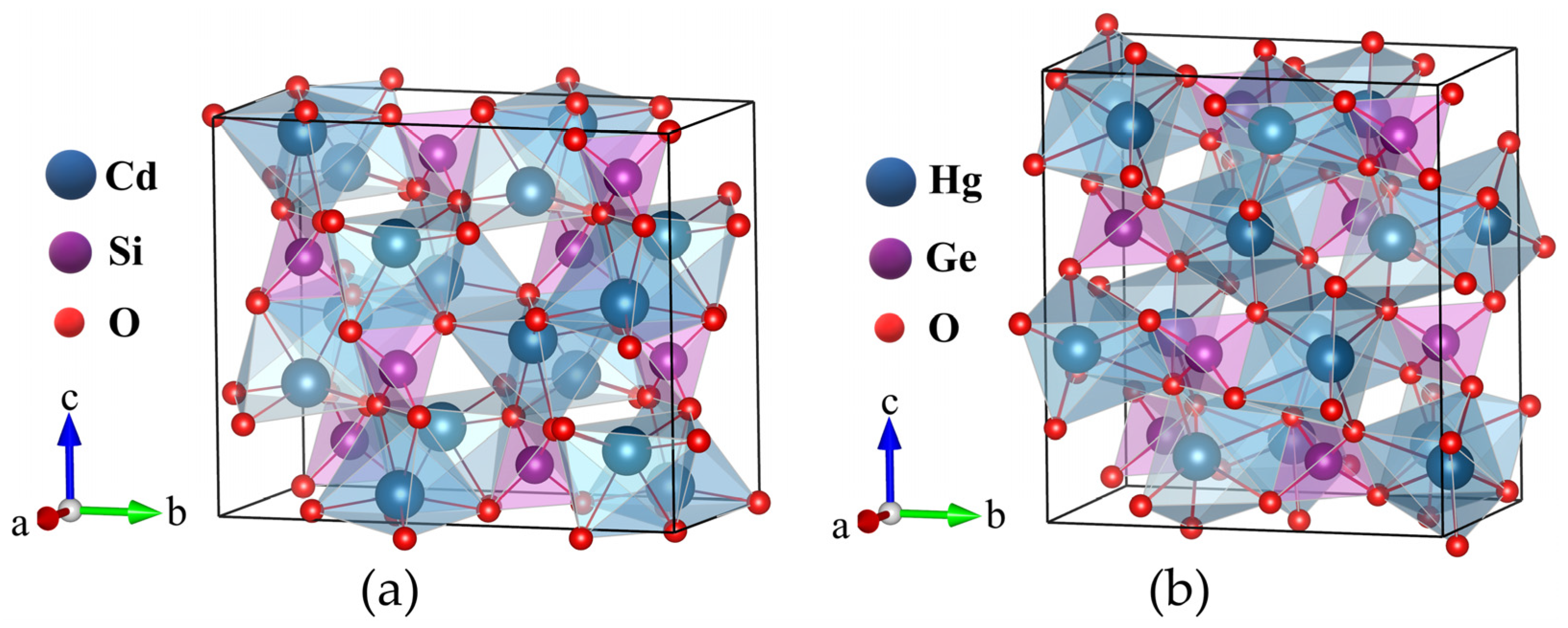
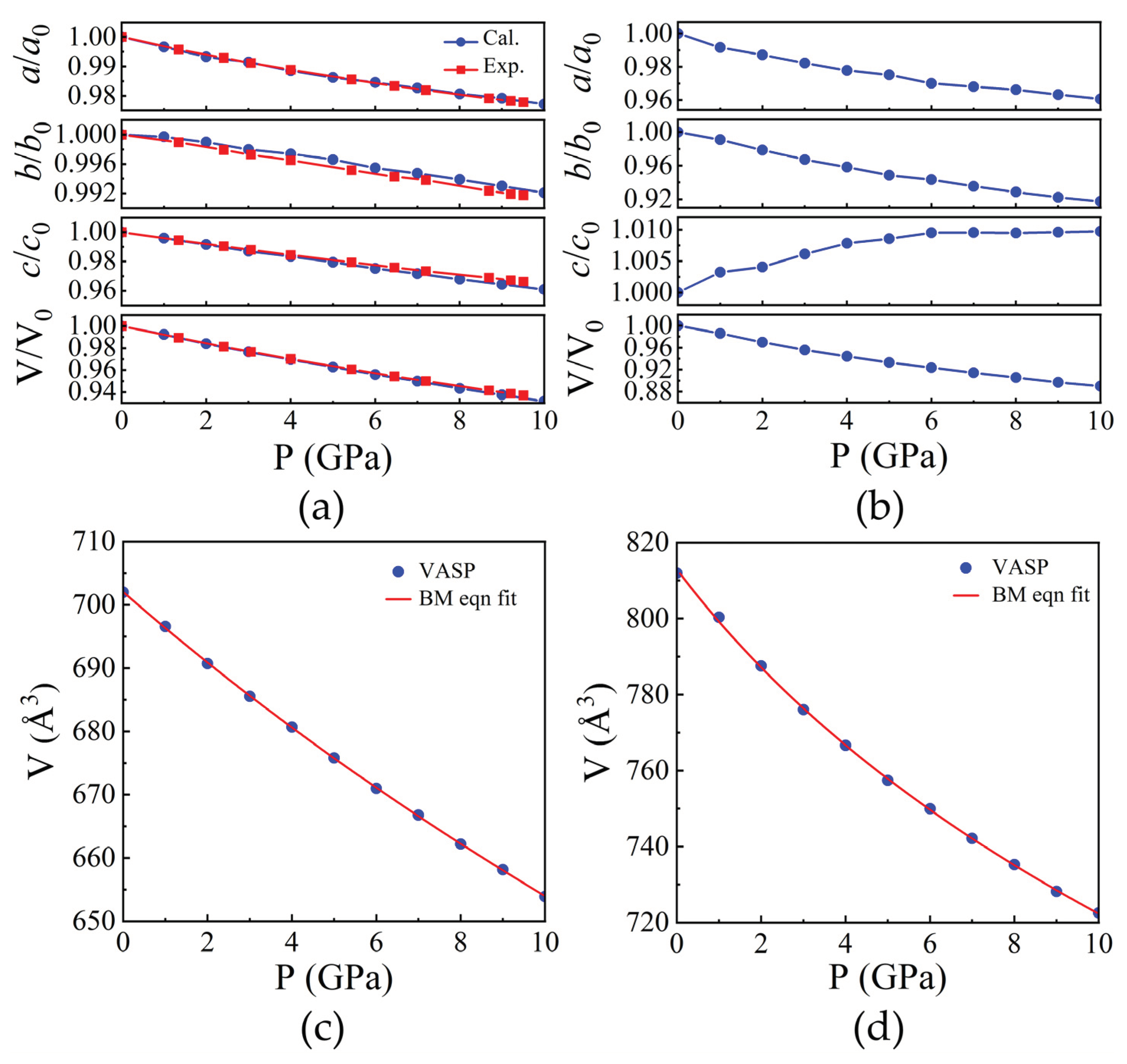
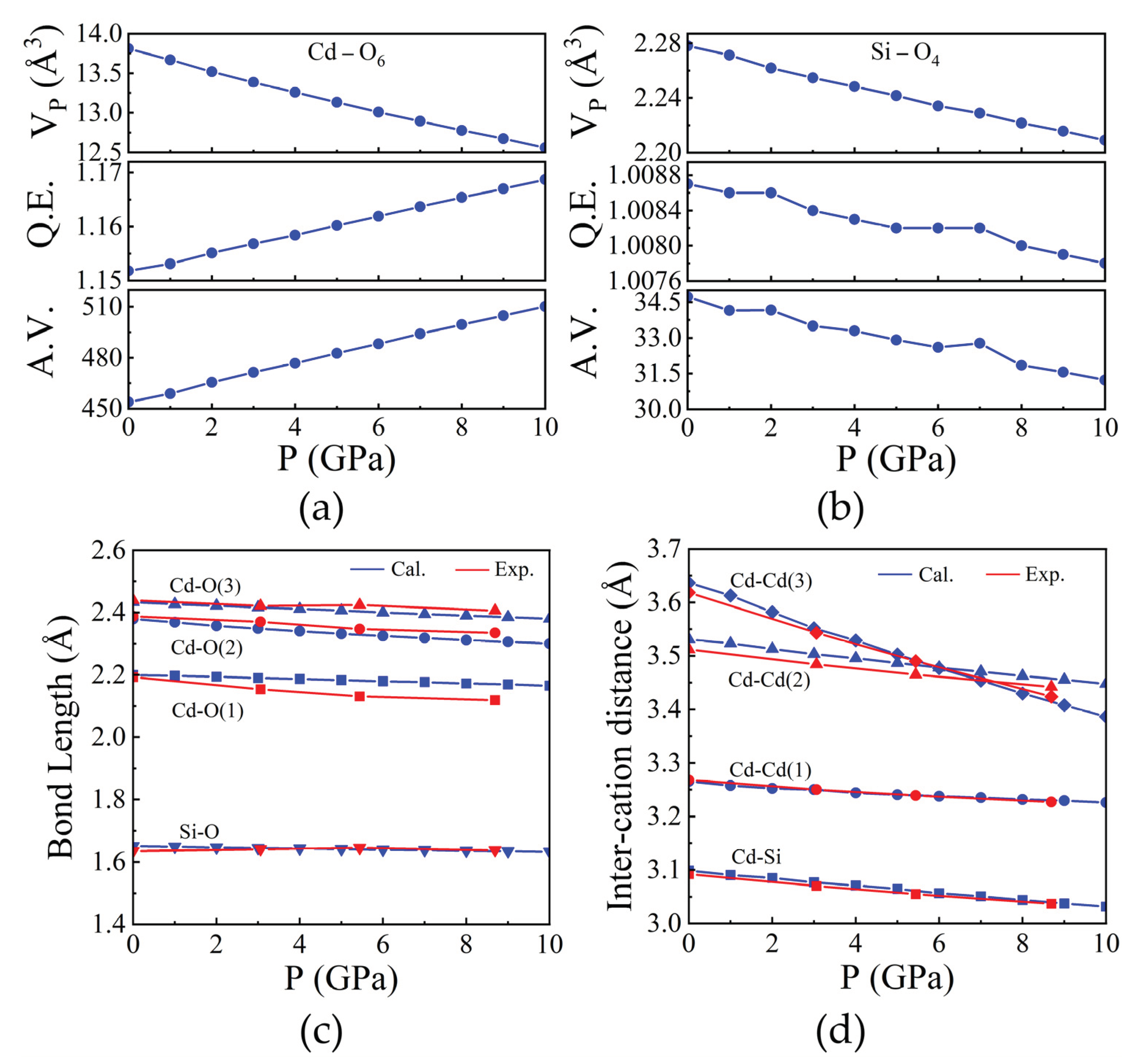
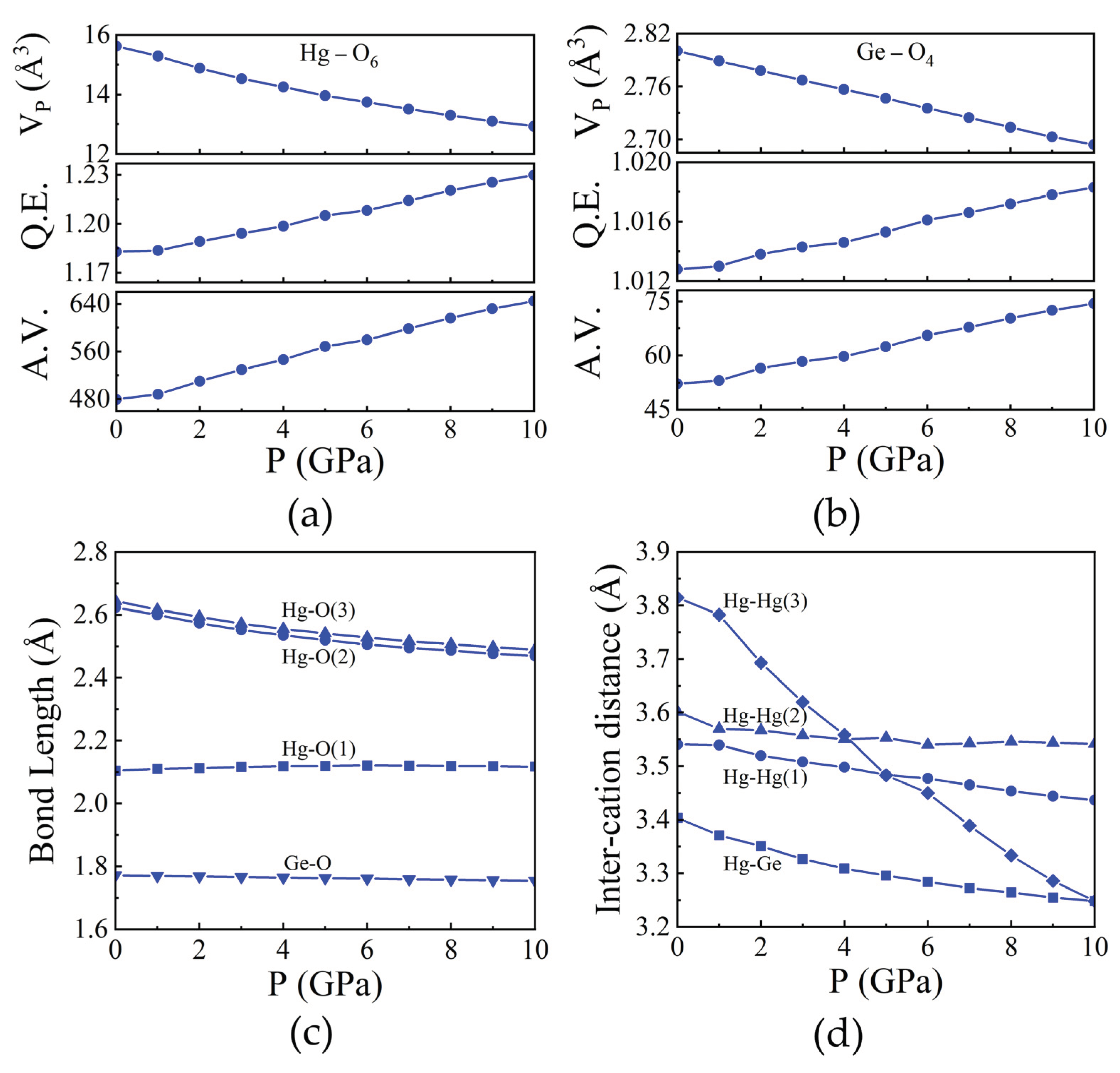
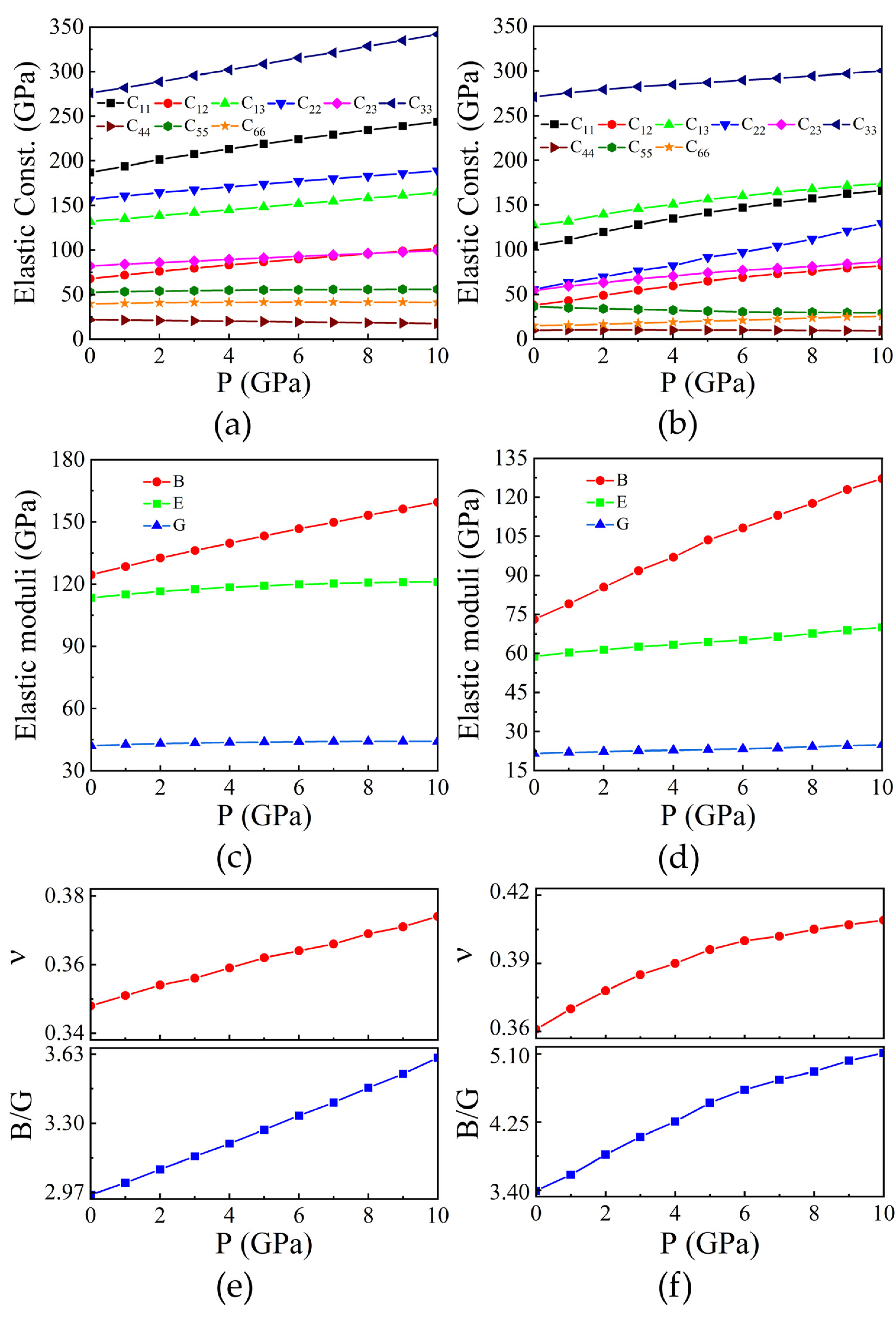
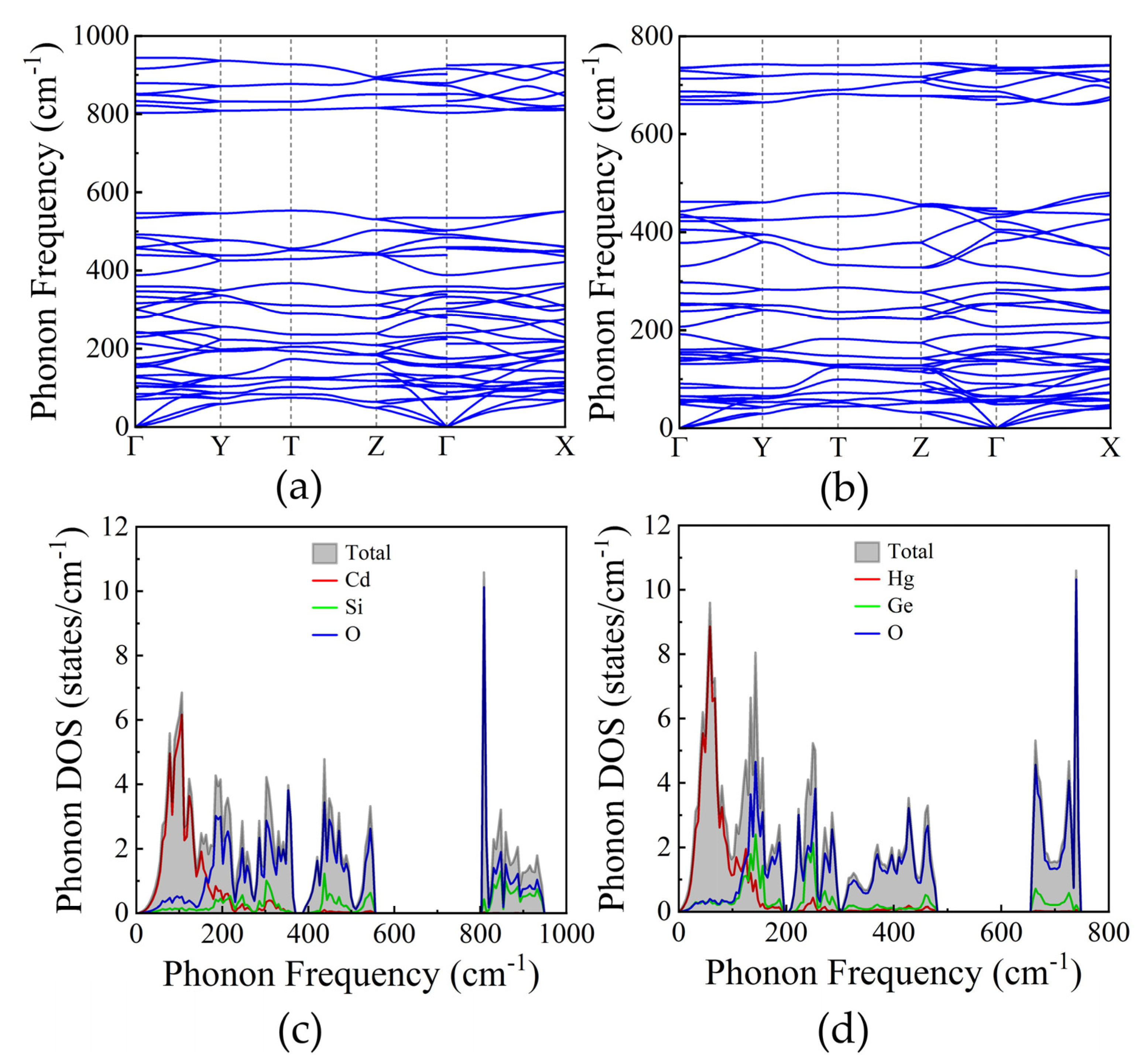
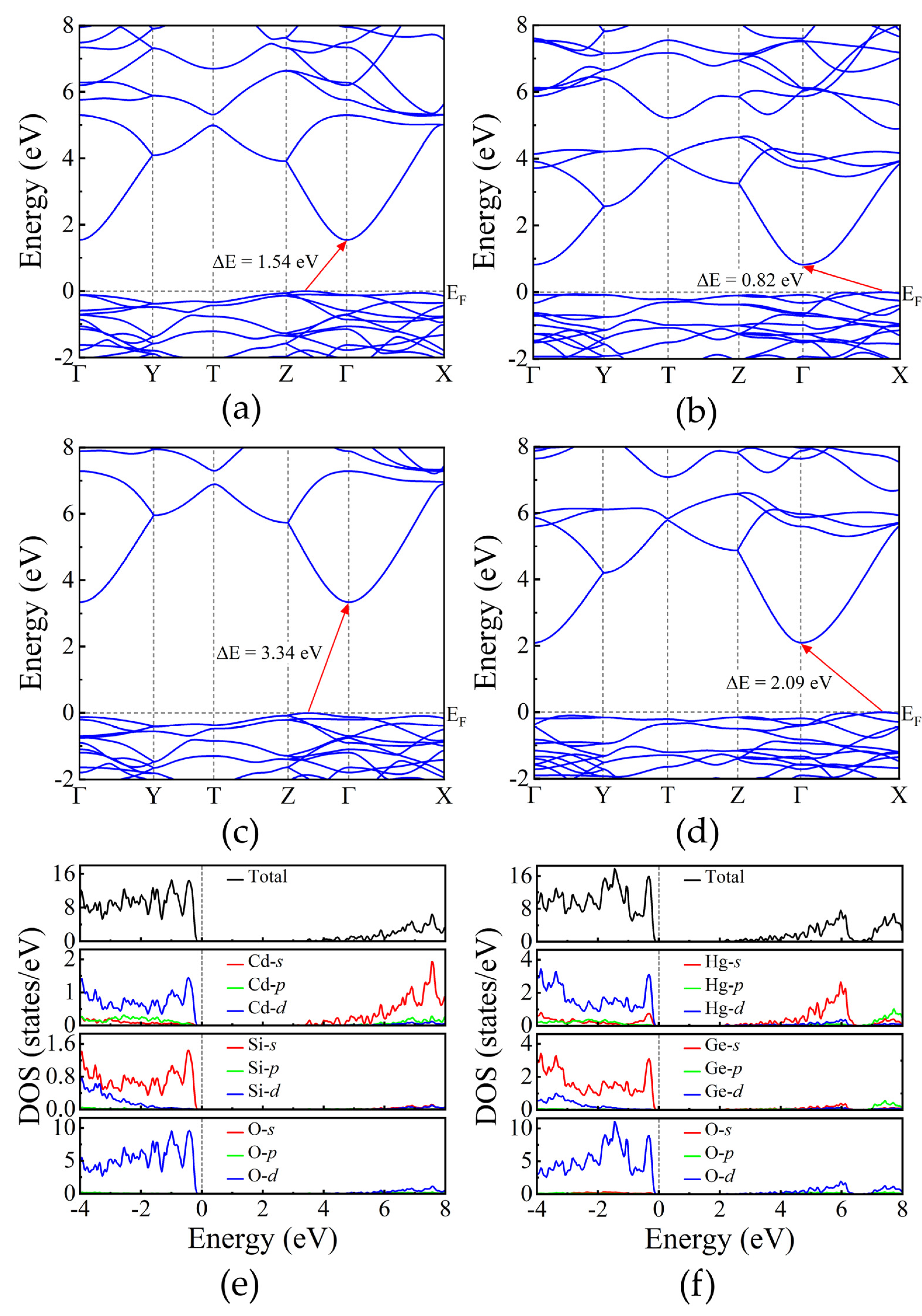
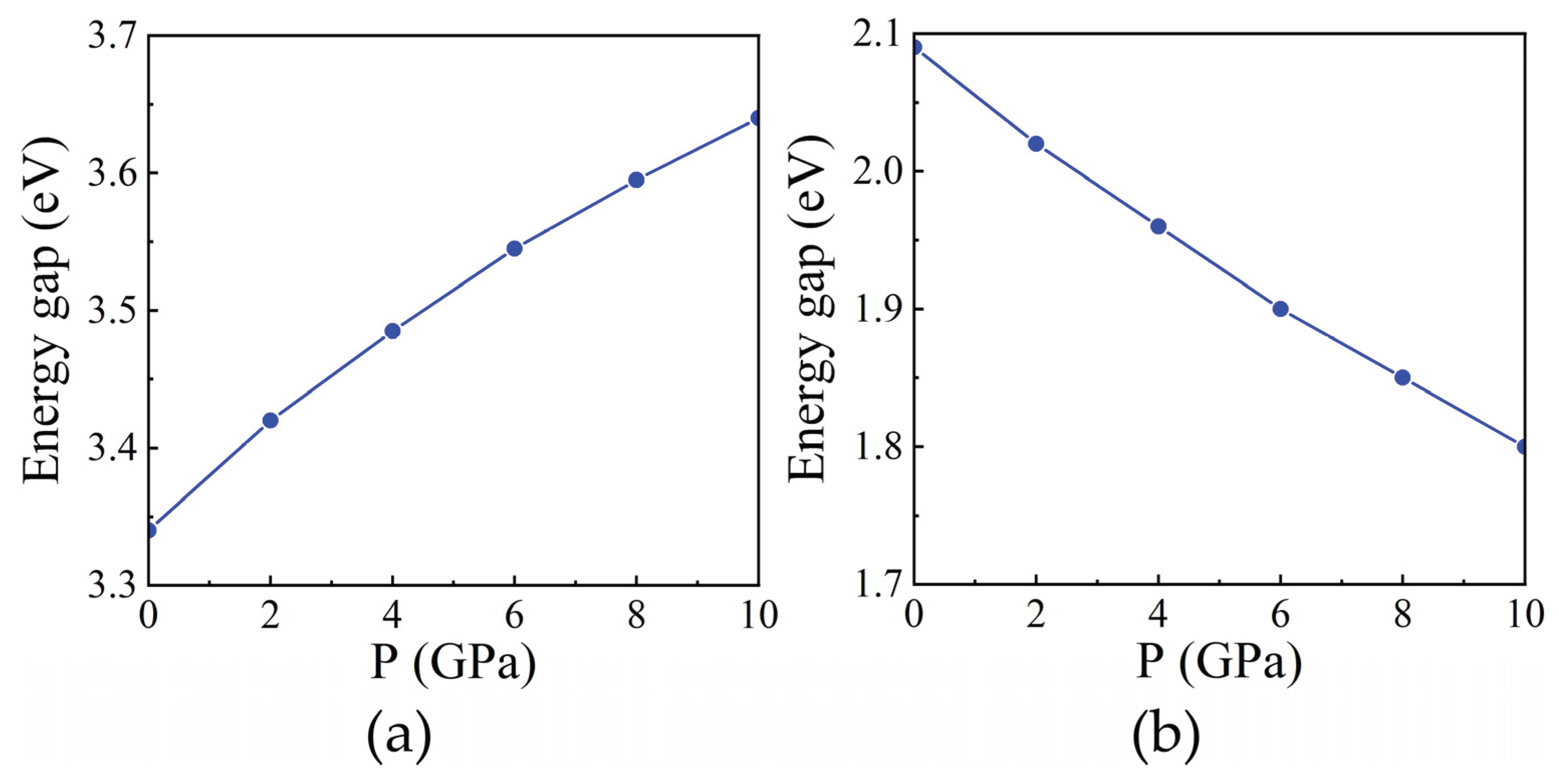
| Compound | PBE | PBEsol | Expt. [6,15] | |
|---|---|---|---|---|
| Cd2SiO4 | a (Å) | 6.100 | 6.008 | 6.011 |
| b (Å) | 12.005 | 11.883 | 11.805 | |
| c (Å) | 10.015 | 9.834 | 9.802 | |
| V (Å3) | 733.44 | 701.97 | 695.60 | |
| Hg2GeO4 | a (Å) | 6.728 | 6.552 | 6.603 |
| b (Å) | 11.305 | 10.621 | 10.596 | |
| c (Å) | 11.661 | 11.667 | 11.485 | |
| V (Å3) | 886.88 | 811.93 | 803.55 |
| Compound | Atom | x | y | z |
|---|---|---|---|---|
| Cd2SiO4 | Cd(1) | 0.1250 | 0.1250 | 0.4401 |
| Cd(2) | 0.8750 | 0.8750 | 0.5599 | |
| Cd(3) | 0.3750 | 0.8750 | 0.6901 | |
| Si(1) | 0.1250 | 0.1250 | 0.1250 | |
| Si(2) | 0.8750 | 0.8750 | 0.8750 | |
| O(1) | 0.9689 | 0.0508 | 0.2301 | |
| O(2) | 0.0311 | 0.9492 | 0.7699 | |
| O(3) | 0.7811 | 0.6992 | 0.2301 | |
| O(4) | 0.2189 | 0.3008 | 0.7699 | |
| O(5) | 0.7811 | 0.0508 | 0.5199 | |
| O(6) | 0.2189 | 0.9492 | 0.4801 | |
| O(7) | 0.9689 | 0.6992 | 0.5199 | |
| O(8) | 0.0310 | 0.3008 | 0.4801 | |
| Hg2GeO4 | Hg(1) | 0.1250 | 0.4454 | 0.1250 |
| Hg(2) | 0.8750 | 0.5546 | 0.8750 | |
| Hg(3) | 0.3750 | 0.6954 | 0.8750 | |
| Ge(1) | 0.1250 | 0.1250 | 0.1250 | |
| Ge(2) | 0.8750 | 0.8750 | 0.8750 | |
| O(1) | 0.9783 | 0.2319 | 0.0425 | |
| O(2) | 0.0217 | 0.7681 | 0.9574 | |
| O(3) | 0.7717 | 0.5181 | 0.0425 | |
| O(4) | 0.2283 | 0.4819 | 0.9574 | |
| O(5) | 0.7717 | 0.2319 | 0.7074 | |
| O(6) | 0.2283 | 0.7681 | 0.2925 | |
| O(7) | 0.9783 | 0.5181 | 0.7074 | |
| O(8) | 0.0217 | 0.4819 | 0.2925 |
| Compound | P(GPa) | A1 | A2 | A3 | AB | AG | AU |
|---|---|---|---|---|---|---|---|
| Cd2SiO4 | 0 | 0.4375 | 0.7863 | 0.7614 | 0.0568 | 0.0779 | 0.9658 |
| 2 | 0.3958 | 0.7686 | 0.7643 | 0.0520 | 0.0869 | 1.0613 | |
| 4 | 0.3598 | 0.7486 | 0.7603 | 0.0505 | 0.0977 | 1.1889 | |
| 6 | 0.3276 | 0.7254 | 0.7500 | 0.0498 | 0.1101 | 1.3420 | |
| 8 | 0.2997 | 0.7016 | 0.7367 | 0.0498 | 0.1230 | 1.5077 | |
| 10 | 0.2731 | 0.6760 | 0.7188 | 0.0499 | 0.1380 | 1.7055 | |
| Hg2GeO4 | 0 | 0.3260 | 0.6662 | 0.7101 | 0.3245 | 0.2199 | 3.7801 |
| 2 | 0.3371 | 0.6137 | 0.7262 | 0.2639 | 0.1972 | 3.1736 | |
| 4 | 0.3410 | 0.5733 | 0.7764 | 0.2193 | 0.1852 | 2.8348 | |
| 6 | 0.3409 | 0.5246 | 0.7973 | 0.1772 | 0.1808 | 2.6384 | |
| 8 | 0.3310 | 0.4933 | 0.8050 | 0.1459 | 0.1870 | 2.6420 | |
| 10 | 0.3104 | 0.4591 | 0.7787 | 0.1191 | 0.1975 | 2.732 |
| Compound | P(GPa) | ρ (gm/cc) | vl (km/s) | vt (km/s) | vm (km/s) | θD |
|---|---|---|---|---|---|---|
| Cd2SiO4 | 0 | 5.9973 | 5.4857 | 2.6479 | 2.9763 | 381.45 |
| 2 | 6.0949 | 5.5822 | 2.6569 | 2.9887 | 385.11 | |
| 4 | 6.1848 | 5.6551 | 2.6550 | 2.9885 | 386.98 | |
| 6 | 6.2744 | 5.7198 | 2.6466 | 2.9812 | 387.88 | |
| 8 | 6.3578 | 5.7737 | 2.6346 | 2.9696 | 388.07 | |
| 10 | 6.4383 | 5.8208 | 2.6172 | 2.9518 | 387.37 | |
| Hg2GeO4 | 0 | 8.7991 | 3.4010 | 1.5646 | 1.7628 | 215.23 |
| 2 | 9.0717 | 3.5619 | 1.5657 | 1.7677 | 218.03 | |
| 4 | 9.3188 | 3.6957 | 1.5632 | 1.7674 | 219.96 | |
| 6 | 9.5266 | 3.8229 | 1.5628 | 1.7690 | 221.78 | |
| 8 | 9.7168 | 3.9256 | 1.5749 | 1.7838 | 225.11 | |
| 10 | 9.8873 | 4.0251 | 1.5853 | 1.7966 | 228.06 |
| Cd2SiO4 | Hg2GeO4 | ||||
|---|---|---|---|---|---|
| Mode | RAMAN/IR active |
Frequency (cm-1) |
Mode | RAMAN/IR active |
Frequency (cm-1) |
| B3g | RAMAN | 70.48 | B1g | RAMAN | 48.66 |
| B2g | RAMAN | 77.06 | B3u | IR | 52.15 |
| B3u | IR | 84.64 | B2g | RAMAN | 54.79 |
| Ag | RAMAN | 103.24 | B3g | RAMAN | 55.31 |
| B1g | RAMAN | 104.33 | Ag | RAMAN | 58.19 |
| Au | IR | 111.70 | Au | IR | 65.15 |
| B3g | RAMAN | 126.47 | B1u | IR | 65.44 |
| B1u | IR | 130.56 | B3g | RAMAN | 82.04 |
| B1g | RAMAN | 153.06 | B1g | RAMAN | 90.45 |
| B1g | RAMAN | 159.24 | B2u | IR | 106.81 |
| B2g | RAMAN | 160.85 | B3u | IR | 131.11 |
| B2u | IR | 174.60 | B1g | RAMAN | 137.11 |
| B3u | IR | 176.64 | B2g | RAMAN | 138.72 |
| B1u | IR | 213.17 | B3g | RAMAN | 150.48 |
| B3g | RAMAN | 230.41 | B2g | RAMAN | 155.27 |
| B2g | RAMAN | 240.23 | B1u | IR | 160.18 |
| B3u | IR | 280.10 | B2u | IR | 191.72 |
| B2u | IR | 286.03 | Ag | RAMAN | 207.15 |
| Ag | RAMAN | 302.00 | B3u | IR | 238.31 |
| B1u | IR | 316.32 | B1u | IR | 250.96 |
| B1g | RAMAN | 332.81 | Au | IR | 254.10 |
| B3g | RAMAN | 346.75 | B1g | RAMAN | 275.48 |
| Au | IR | 359.30 | B3g | RAMAN | 297.23 |
| Ag | RAMAN | 388.13 | Ag | RAMAN | 330.62 |
| B3u | IR | 439.61 | B3u | IR | 377.96 |
| B1u | IR | 456.44 | B2u | IR | 400.32 |
| B3g | RAMAN | 460.04 | B3g | RAMAN | 404.92 |
| Au | IR | 484.22 | B1u | IR | 422.41 |
| B1g | RAMAN | 491.78 | B1g | RAMAN | 430.53 |
| B2u | IR | 502.84 | B2g | RAMAN | 435.91 |
| B2g | RAMAN | 534.46 | Au | IR | 442.38 |
| Au | IR | 803.04 | B1u | IR | 661.33 |
| Ag | RAMAN | 822.00 | B3u | IR | 669.70 |
| B1u | IR | 833.21 | B3g | RAMAN | 676.43 |
| B3u | IR | 849.23 | B1g | RAMAN | 686.86 |
| B3g | RAMAN | 851.31 | B2u | IR | 695.40 |
| B2u | IR | 872.81 | Au | IR | 729.19 |
| B1g | RAMAN | 878.83 | B2g | RAMAN | 734.43 |
| B2g | RAMAN | 915.79 | Ag | RAMAN | 735.64 |
Disclaimer/Publisher’s Note: The statements, opinions and data contained in all publications are solely those of the individual author(s) and contributor(s) and not of MDPI and/or the editor(s). MDPI and/or the editor(s) disclaim responsibility for any injury to people or property resulting from any ideas, methods, instructions or products referred to in the content. |
© 2024 by the authors. Licensee MDPI, Basel, Switzerland. This article is an open access article distributed under the terms and conditions of the Creative Commons Attribution (CC BY) license (http://creativecommons.org/licenses/by/4.0/).





